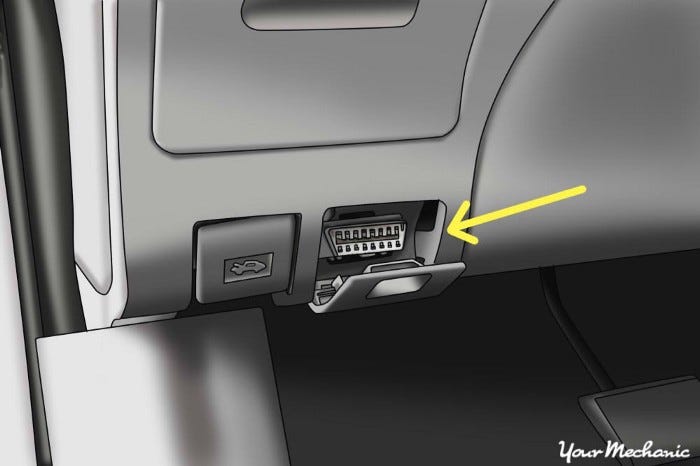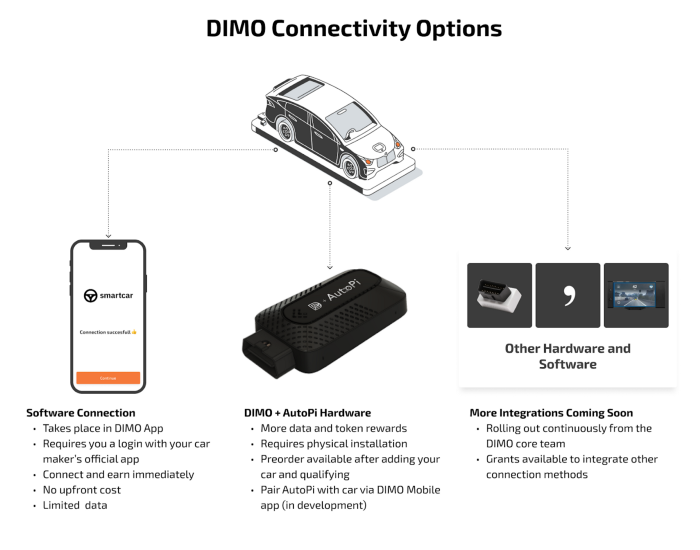How A Car Connects To DIMO
DIMO is a user-owned IoT platform that allows users to maximize the value of their connected assets, starting with cars.
Our first product allows drivers to stream vehicle data in exchange for tokens — practically employing Web3 technology to build an open mobility ecosystem.
If you’re a driver who wants to connect your car to DIMO so that you can Drive-to-Earn or benefit from seeing your vehicle data, use this as a guide to understand your connectivity options, and add your car to DIMO as a first step! We’re accepting new users to our beta on a first-come-first-served basis.
If there’s no connection option available today for your vehicle, don’t worry! By adding your VIN (vehicle identification number) you are creating a signal that we need to support your car — we intend to support every vehicle & transportation mode over time.
Keep reading to understand what’s available to drivers today.
Your Connection Options
We’ve been testing the platform ourselves for months, and we’re excited to begin sharing it with the world. There are going to be some excellent apps built on DIMO that we never could have thought of ourselves!
DIMO is designed to work with any vehicle (and eventually any IoT device), but to get started there are two options for drivers.
Broadly, your car can link to DIMO in three broad ways:
- Adding your VIN, which allows the DIMO platform to ID your car and (eventually) to pull in manufacturing, maintenance, and recall information.
- Logging in to your auto maker’s existing connectivity service via DIMO’s handy Smartcar integration
- Via DIMO-enabled hardware plugged into your car which transmits data to the network over an existing cellular connection or other wireless means — for example we’re building support for Helium.
DIMO will offer all 3 means of connecting cars when we launch before rolling out more options over time. Our goal is to provide you with the most complete picture of your vehicle’s health, capabilities, and value — so we want to help you collect all possible data about it!
Getting started with an existing connected vehicle service
If you have a connected car subscription with your auto OEM (e.g., Ford, Tesla, Toyota), you can connect to DIMO using that username and password. To power this, we use Smartcar, which is like Plaid (how most websites will integrate with your bank) but for your car.
It’s a great option because if your car is supported, you can connect it immediately instead of waiting for hardware or physically installing a device. The tradeoff is that you’ll see less data about your car and earn lower rewards. There are also privacy implications that vary based on vehicle OEM (GM, Ford, Toyota, Tesla etc) of using your existing connected vehicle service. We’ll detail these in a later post.
There are two other requirements that might affect your ability to connect:
- Smartcar supports a wide number of cars which total over 72 million vehicles on the road. Even so, not every car can connect with Smartcar. You can check their vehicle compatibility to see if your car is supported or you can just sign up with DIMO and we’ll tell you.
- You must have an account with your automaker’s app. These apps, like FordPass or OnStar, are becoming more and more common — and if you have gotten a new car in the last few years, you may have one.
All in all, this software connection is easy, lets you start earning tokens right away, and it does not disqualify you from upgrading to a hardware option that can earn you more tokens later.
Getting started with DIMO x AutoPi Hardware v1
We’re also launching a hardware option for DIMO. While this connection option yields the highest data collection and rewards functionality, it brings different pros and cons to a driver.
All cars are technically compatible with the DIMO x AutoPi hardware: the device plugs into the universal car data port, known as the OBD2 port, which virtually every car has. You might be familiar with insurance dongles like Progressive Snapshot or Metromile which use this port for siloed “Smart Insurance” applications where you trade your data for cheaper rates on car insurance.


Initially, we are limiting initial access to hardware in two ways while we build the infrastructure and operations to support all vehicles:
- The car must be located in the US or Canada.
- The car must be less than ten years old.
It is strongly encouraged (but not required) to add your VIN before ordering an AutoPi, this way we can make sure your car is properly supported, and eventually provide you with an estimate of your expected token rewards and services available when you connect.
We’re working to expand the pool of eligible countries and vehicle types as quickly as we can. If you’re technical, it is also possible to join the DIMO community and receive support for adding your existing vehicles by providing DBC codes for your car — particularly if you’re unlocking that capability for other users. Our goal is to support every vehicle in the world!
A Note on OBD2 Data
Data from the OBD2 port comes off the car encoded, and each car maker encodes data differently. The good news is that many of these codes — called DBC Codes — are available publicly. Communities of car hackers have been decoding cars and publishing these codes open-source. This makes car data more open — it’s no longer something that only the manufacturer or dealer can read and build applications for.
Despite all the great work from communities like OpenDBC, you may still have a car that is not adequately decoded — meaning installing an AutoPi would yield limited or potentially even no data directly from the car (although the device itself always provides some data, as long as it has power). This could impact rewards and functionality.
Drivers who have a car that is eligible for an AutoPi can check in their account and pre-order from shop.dimo.zone.


Roadmap: More connections to come
We’re planning to roll out other connection methods for vehicles in 2022. A few on our roadmap are for Q1 are:
- Dedicated Tesla API Integration: This will give Tesla owners more detail about their vehicle than they get with Smartcar alone. Also, since the Tesla API provides so much data relative to any other automakers, Teslas will not need hardware to earn more rewards.
- Comma.ai Integration: A special Comma.ai integration that will allow people running comma.ai to stream their data to DIMO.
Geography: Rolling out slowly to scale properly
One other variable that may affect how you can connect is where you’re located. There are various technical requirements for data transmission, verification, and storage depending on where a particular vehicle is located. There are also different vehicles and integrations required to stream data from vehicles in different regions.
DIMO will be starting with cars in the US and Canada, and then moving to expand to other regions.
Regardless of where you are in the world, we encourage you to register an account and add your car to indicate interest and make sure you’re aware of when we can support your vehicle. You can also join our dedicated international support channel in discord
Rewards and Compatibility
We have detailed in our documentation how tokens are issued, but it’s worth adding a bit of detail here. Much the same way that Helium rewards vary based on your location, the location of nearby hotspots, and installation factors like your antenna size and placement, DIMO rewards will vary based on a set of factors.
There are two large categories of variables that will affect your rewards:
- Connection method
- Demand variables, set by the “demand signal”
Connection Method
As mentioned above, different connection methods provide different depths of data. Think about the difference between SMS and LTE. Both allow you to send text messages, but one lets you stream video — the other doesn’t. More data is always better, so using a connection method that provides more data is always going to earn a driver more rewards.
Demand Signal: The value of your data will change dynamically
Right now, DIMO is setting aside token rewards out of the initial token issuance for users — and the DAO will help to create the initial demand for that data. More importantly, DIMO is a market-based system, so we’re going to allow developers and enterprises to create their own demand for data. This means that as an economy emerges around the DIMO platform, the rewards for Drive-to-Earn will adjust dynamically with demand-driven market forces.
To illustrate: Today DIMO is rewarding new electric vehicles with a higher share of available rewards. We believe that the data from EVs is particularly valuable since the batteries and battery management systems — which have been developed at the cost of tens of billions by automakers — are so new and so riddled with problems. But as DIMO becomes a market system, those who want different data may choose to incentivize new Drive-to-Earn rewards for different vehicle types.
Learning More
Anyone who wants to learn more can find much more detail about token rewards and technical roadmap in our documentation. As with any open project, you can also contribute your opinion to the DAO, or submit a proposal about modifying the token issuance.
Get Started
You can sign up for a DIMO account and add a vehicle (or vehicles) today. We’ll notify you when we’re ready to help you connect your car, which should only be a few weeks.
If you’re looking to join the DAO and community, you can find us at our Discord Server. We also know that there’s great interest in deciphering and understanding car data — so in addition to those who want to send us vehicle data, we’re building a community around those who want to decode vehicle data. Car hackers and tinkerers around the world who have been working on this for years? There’s a place for you in DIMO, too.
Andy Chatham has spent 10 years in the mobility space operating some of the largest autonomous and electric vehicle fleets, and building software used by millions of passengers. Before DIMO, he worked for Transdev managing a team of hundreds working on Waymo—Google’s self-driving car division. He’s also worked across many other domains in the mobility world, helping transit and real estate partners leverage new technologies and deploy mobility-as-a-service solutions.